Assessment of Disclosures in Relation to Finance Leases under AASB 117
VerifiedAdded on 2023/06/11
|6
|1542
|413
AI Summary
This study assesses the disclosures related to finance leases as per AASB 117 (IAS 17). It covers the disclosures required for lessees and lessors, manufacturing associations, and criteria for dealer lessors. It also discusses the liabilities and accounting treatment of finance leases.
Contribute Materials
Your contribution can guide someone’s learning journey. Share your
documents today.
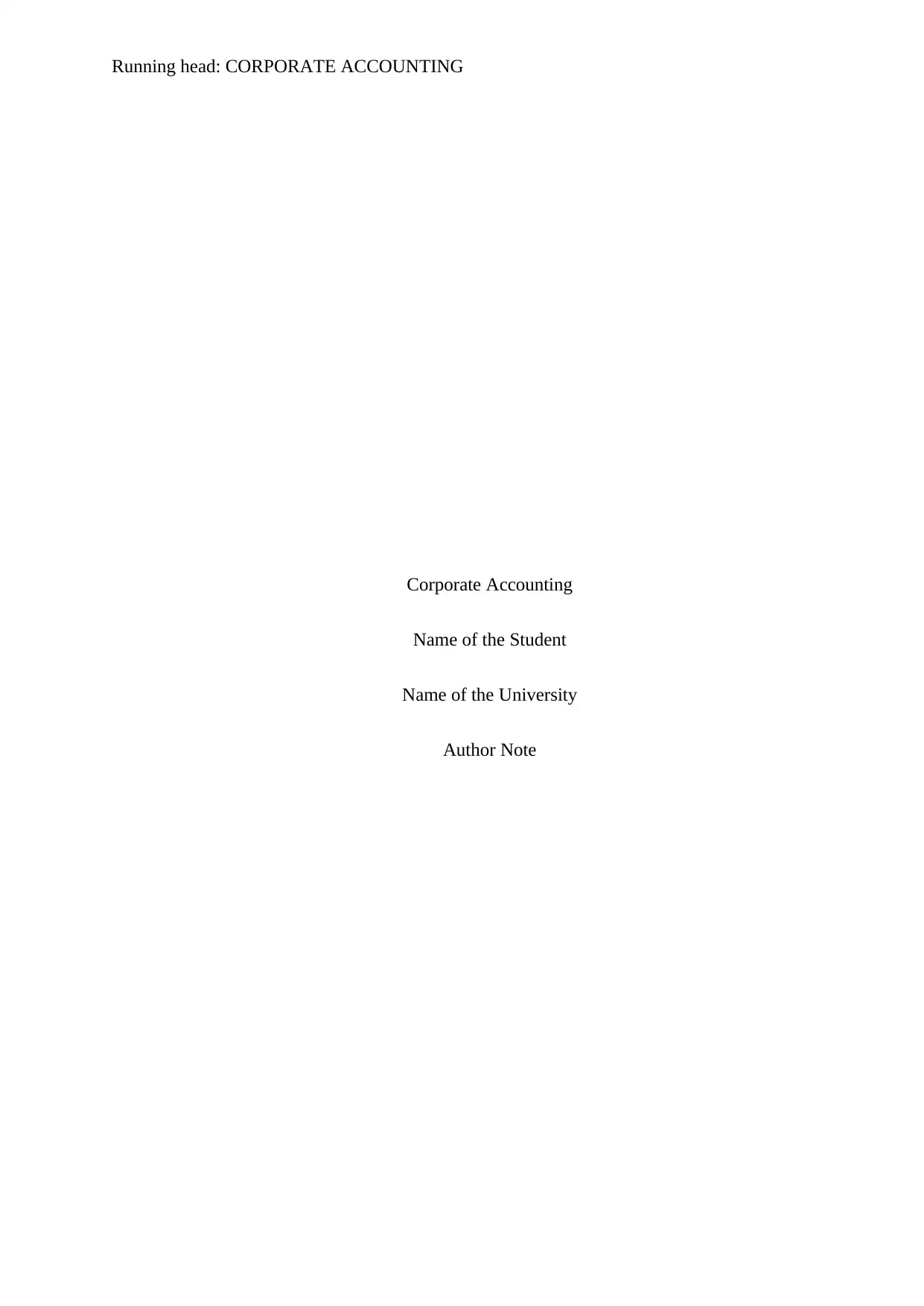
Running head: CORPORATE ACCOUNTING
Corporate Accounting
Name of the Student
Name of the University
Author Note
Corporate Accounting
Name of the Student
Name of the University
Author Note
Secure Best Marks with AI Grader
Need help grading? Try our AI Grader for instant feedback on your assignments.
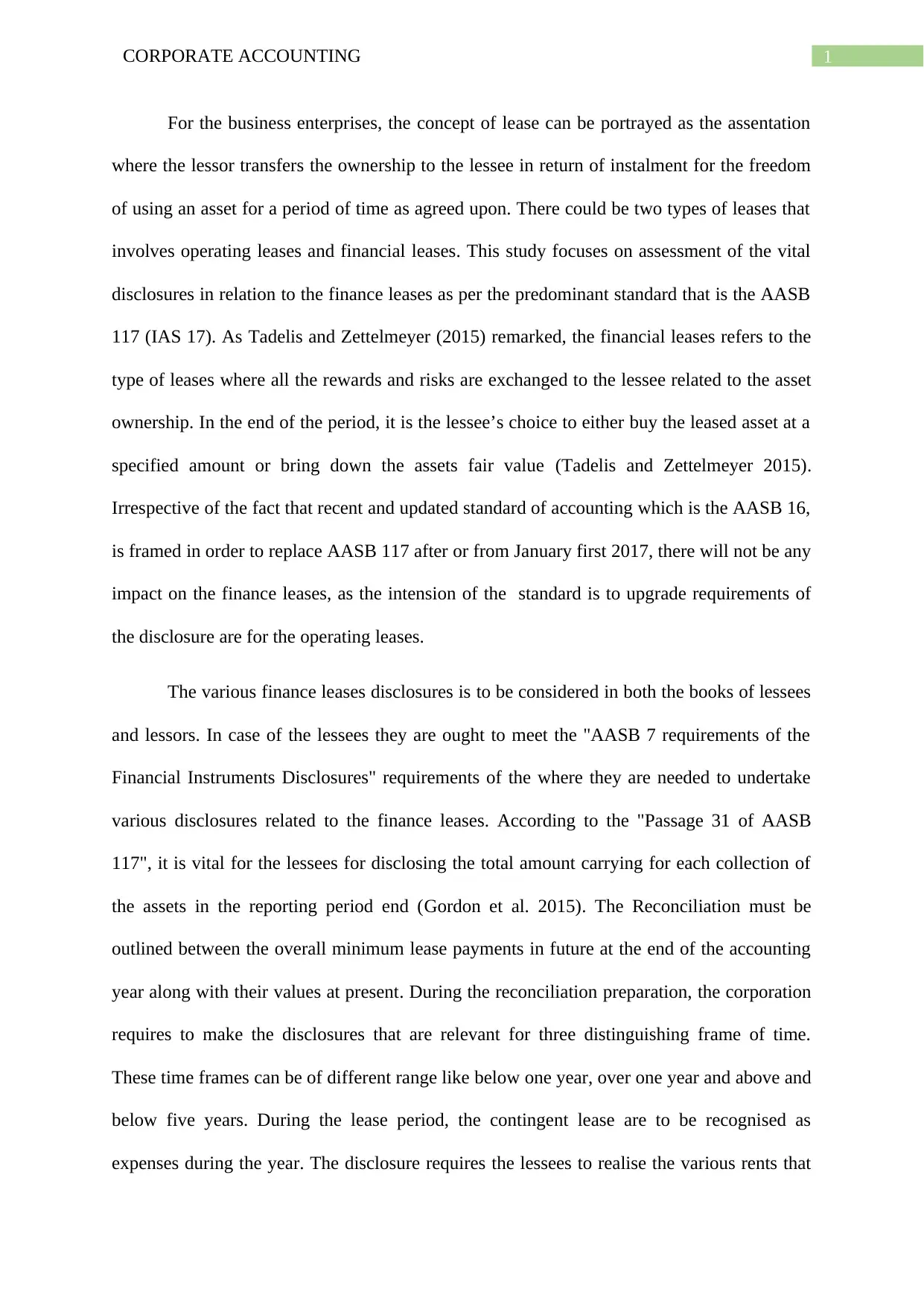
1CORPORATE ACCOUNTING
For the business enterprises, the concept of lease can be portrayed as the assentation
where the lessor transfers the ownership to the lessee in return of instalment for the freedom
of using an asset for a period of time as agreed upon. There could be two types of leases that
involves operating leases and financial leases. This study focuses on assessment of the vital
disclosures in relation to the finance leases as per the predominant standard that is the AASB
117 (IAS 17). As Tadelis and Zettelmeyer (2015) remarked, the financial leases refers to the
type of leases where all the rewards and risks are exchanged to the lessee related to the asset
ownership. In the end of the period, it is the lessee’s choice to either buy the leased asset at a
specified amount or bring down the assets fair value (Tadelis and Zettelmeyer 2015).
Irrespective of the fact that recent and updated standard of accounting which is the AASB 16,
is framed in order to replace AASB 117 after or from January first 2017, there will not be any
impact on the finance leases, as the intension of the standard is to upgrade requirements of
the disclosure are for the operating leases.
The various finance leases disclosures is to be considered in both the books of lessees
and lessors. In case of the lessees they are ought to meet the "AASB 7 requirements of the
Financial Instruments Disclosures" requirements of the where they are needed to undertake
various disclosures related to the finance leases. According to the "Passage 31 of AASB
117", it is vital for the lessees for disclosing the total amount carrying for each collection of
the assets in the reporting period end (Gordon et al. 2015). The Reconciliation must be
outlined between the overall minimum lease payments in future at the end of the accounting
year along with their values at present. During the reconciliation preparation, the corporation
requires to make the disclosures that are relevant for three distinguishing frame of time.
These time frames can be of different range like below one year, over one year and above and
below five years. During the lease period, the contingent lease are to be recognised as
expenses during the year. The disclosure requires the lessees to realise the various rents that
For the business enterprises, the concept of lease can be portrayed as the assentation
where the lessor transfers the ownership to the lessee in return of instalment for the freedom
of using an asset for a period of time as agreed upon. There could be two types of leases that
involves operating leases and financial leases. This study focuses on assessment of the vital
disclosures in relation to the finance leases as per the predominant standard that is the AASB
117 (IAS 17). As Tadelis and Zettelmeyer (2015) remarked, the financial leases refers to the
type of leases where all the rewards and risks are exchanged to the lessee related to the asset
ownership. In the end of the period, it is the lessee’s choice to either buy the leased asset at a
specified amount or bring down the assets fair value (Tadelis and Zettelmeyer 2015).
Irrespective of the fact that recent and updated standard of accounting which is the AASB 16,
is framed in order to replace AASB 117 after or from January first 2017, there will not be any
impact on the finance leases, as the intension of the standard is to upgrade requirements of
the disclosure are for the operating leases.
The various finance leases disclosures is to be considered in both the books of lessees
and lessors. In case of the lessees they are ought to meet the "AASB 7 requirements of the
Financial Instruments Disclosures" requirements of the where they are needed to undertake
various disclosures related to the finance leases. According to the "Passage 31 of AASB
117", it is vital for the lessees for disclosing the total amount carrying for each collection of
the assets in the reporting period end (Gordon et al. 2015). The Reconciliation must be
outlined between the overall minimum lease payments in future at the end of the accounting
year along with their values at present. During the reconciliation preparation, the corporation
requires to make the disclosures that are relevant for three distinguishing frame of time.
These time frames can be of different range like below one year, over one year and above and
below five years. During the lease period, the contingent lease are to be recognised as
expenses during the year. The disclosure requires the lessees to realise the various rents that
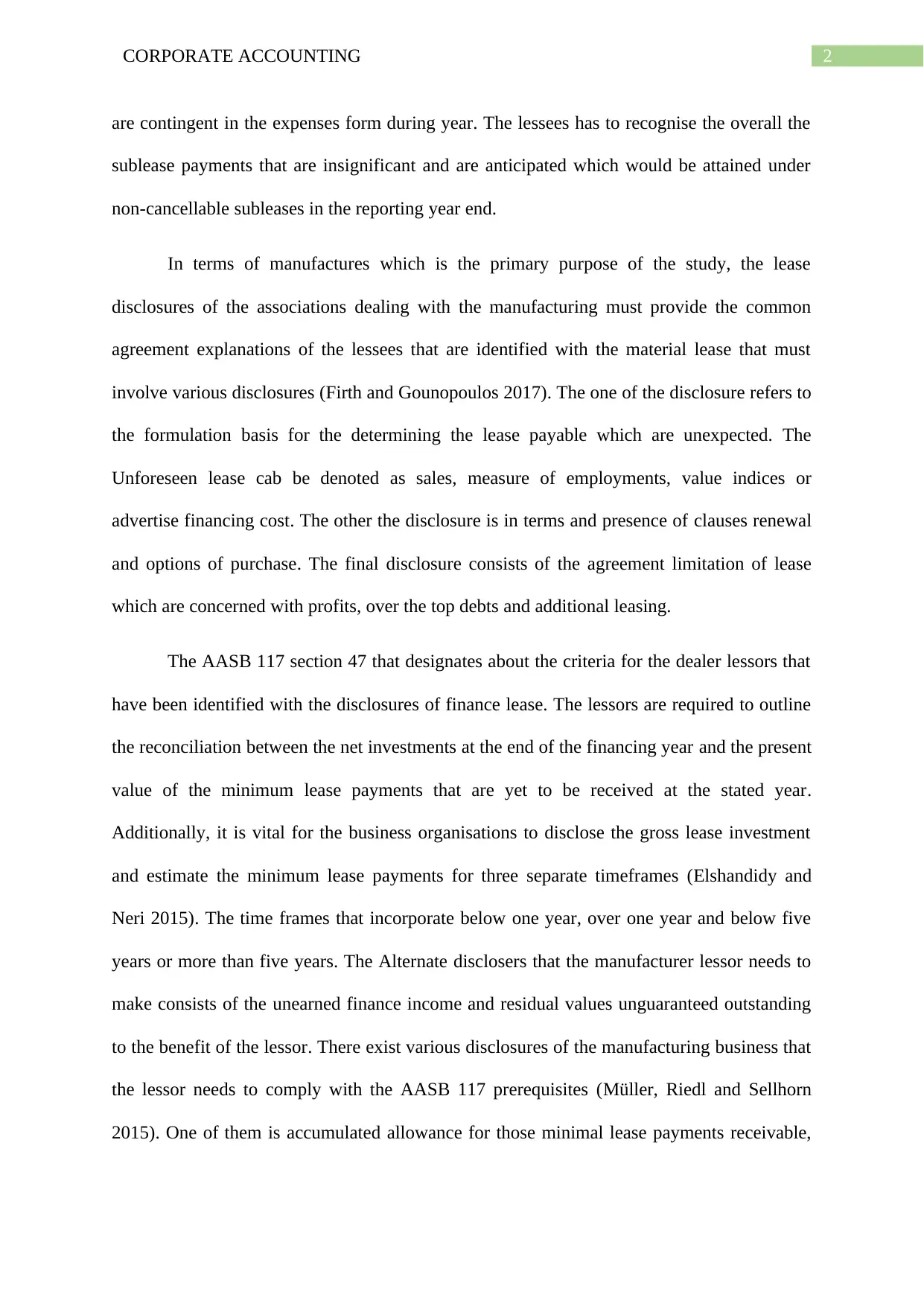
2CORPORATE ACCOUNTING
are contingent in the expenses form during year. The lessees has to recognise the overall the
sublease payments that are insignificant and are anticipated which would be attained under
non-cancellable subleases in the reporting year end.
In terms of manufactures which is the primary purpose of the study, the lease
disclosures of the associations dealing with the manufacturing must provide the common
agreement explanations of the lessees that are identified with the material lease that must
involve various disclosures (Firth and Gounopoulos 2017). The one of the disclosure refers to
the formulation basis for the determining the lease payable which are unexpected. The
Unforeseen lease cab be denoted as sales, measure of employments, value indices or
advertise financing cost. The other the disclosure is in terms and presence of clauses renewal
and options of purchase. The final disclosure consists of the agreement limitation of lease
which are concerned with profits, over the top debts and additional leasing.
The AASB 117 section 47 that designates about the criteria for the dealer lessors that
have been identified with the disclosures of finance lease. The lessors are required to outline
the reconciliation between the net investments at the end of the financing year and the present
value of the minimum lease payments that are yet to be received at the stated year.
Additionally, it is vital for the business organisations to disclose the gross lease investment
and estimate the minimum lease payments for three separate timeframes (Elshandidy and
Neri 2015). The time frames that incorporate below one year, over one year and below five
years or more than five years. The Alternate disclosers that the manufacturer lessor needs to
make consists of the unearned finance income and residual values unguaranteed outstanding
to the benefit of the lessor. There exist various disclosures of the manufacturing business that
the lessor needs to comply with the AASB 117 prerequisites (Müller, Riedl and Sellhorn
2015). One of them is accumulated allowance for those minimal lease payments receivable,
are contingent in the expenses form during year. The lessees has to recognise the overall the
sublease payments that are insignificant and are anticipated which would be attained under
non-cancellable subleases in the reporting year end.
In terms of manufactures which is the primary purpose of the study, the lease
disclosures of the associations dealing with the manufacturing must provide the common
agreement explanations of the lessees that are identified with the material lease that must
involve various disclosures (Firth and Gounopoulos 2017). The one of the disclosure refers to
the formulation basis for the determining the lease payable which are unexpected. The
Unforeseen lease cab be denoted as sales, measure of employments, value indices or
advertise financing cost. The other the disclosure is in terms and presence of clauses renewal
and options of purchase. The final disclosure consists of the agreement limitation of lease
which are concerned with profits, over the top debts and additional leasing.
The AASB 117 section 47 that designates about the criteria for the dealer lessors that
have been identified with the disclosures of finance lease. The lessors are required to outline
the reconciliation between the net investments at the end of the financing year and the present
value of the minimum lease payments that are yet to be received at the stated year.
Additionally, it is vital for the business organisations to disclose the gross lease investment
and estimate the minimum lease payments for three separate timeframes (Elshandidy and
Neri 2015). The time frames that incorporate below one year, over one year and below five
years or more than five years. The Alternate disclosers that the manufacturer lessor needs to
make consists of the unearned finance income and residual values unguaranteed outstanding
to the benefit of the lessor. There exist various disclosures of the manufacturing business that
the lessor needs to comply with the AASB 117 prerequisites (Müller, Riedl and Sellhorn
2015). One of them is accumulated allowance for those minimal lease payments receivable,
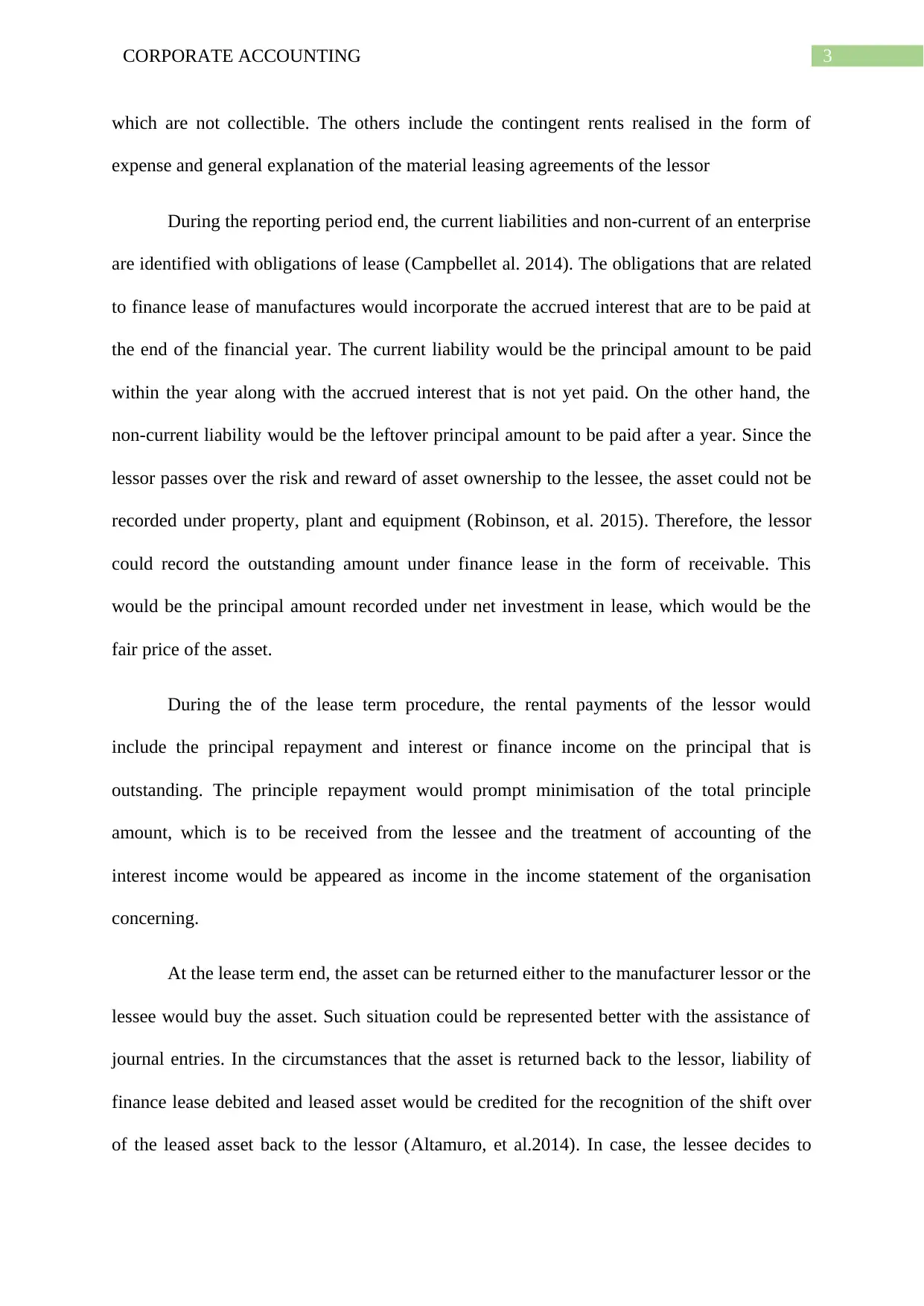
3CORPORATE ACCOUNTING
which are not collectible. The others include the contingent rents realised in the form of
expense and general explanation of the material leasing agreements of the lessor
During the reporting period end, the current liabilities and non-current of an enterprise
are identified with obligations of lease (Campbellet al. 2014). The obligations that are related
to finance lease of manufactures would incorporate the accrued interest that are to be paid at
the end of the financial year. The current liability would be the principal amount to be paid
within the year along with the accrued interest that is not yet paid. On the other hand, the
non-current liability would be the leftover principal amount to be paid after a year. Since the
lessor passes over the risk and reward of asset ownership to the lessee, the asset could not be
recorded under property, plant and equipment (Robinson, et al. 2015). Therefore, the lessor
could record the outstanding amount under finance lease in the form of receivable. This
would be the principal amount recorded under net investment in lease, which would be the
fair price of the asset.
During the of the lease term procedure, the rental payments of the lessor would
include the principal repayment and interest or finance income on the principal that is
outstanding. The principle repayment would prompt minimisation of the total principle
amount, which is to be received from the lessee and the treatment of accounting of the
interest income would be appeared as income in the income statement of the organisation
concerning.
At the lease term end, the asset can be returned either to the manufacturer lessor or the
lessee would buy the asset. Such situation could be represented better with the assistance of
journal entries. In the circumstances that the asset is returned back to the lessor, liability of
finance lease debited and leased asset would be credited for the recognition of the shift over
of the leased asset back to the lessor (Altamuro, et al.2014). In case, the lessee decides to
which are not collectible. The others include the contingent rents realised in the form of
expense and general explanation of the material leasing agreements of the lessor
During the reporting period end, the current liabilities and non-current of an enterprise
are identified with obligations of lease (Campbellet al. 2014). The obligations that are related
to finance lease of manufactures would incorporate the accrued interest that are to be paid at
the end of the financial year. The current liability would be the principal amount to be paid
within the year along with the accrued interest that is not yet paid. On the other hand, the
non-current liability would be the leftover principal amount to be paid after a year. Since the
lessor passes over the risk and reward of asset ownership to the lessee, the asset could not be
recorded under property, plant and equipment (Robinson, et al. 2015). Therefore, the lessor
could record the outstanding amount under finance lease in the form of receivable. This
would be the principal amount recorded under net investment in lease, which would be the
fair price of the asset.
During the of the lease term procedure, the rental payments of the lessor would
include the principal repayment and interest or finance income on the principal that is
outstanding. The principle repayment would prompt minimisation of the total principle
amount, which is to be received from the lessee and the treatment of accounting of the
interest income would be appeared as income in the income statement of the organisation
concerning.
At the lease term end, the asset can be returned either to the manufacturer lessor or the
lessee would buy the asset. Such situation could be represented better with the assistance of
journal entries. In the circumstances that the asset is returned back to the lessor, liability of
finance lease debited and leased asset would be credited for the recognition of the shift over
of the leased asset back to the lessor (Altamuro, et al.2014). In case, the lessee decides to
Secure Best Marks with AI Grader
Need help grading? Try our AI Grader for instant feedback on your assignments.
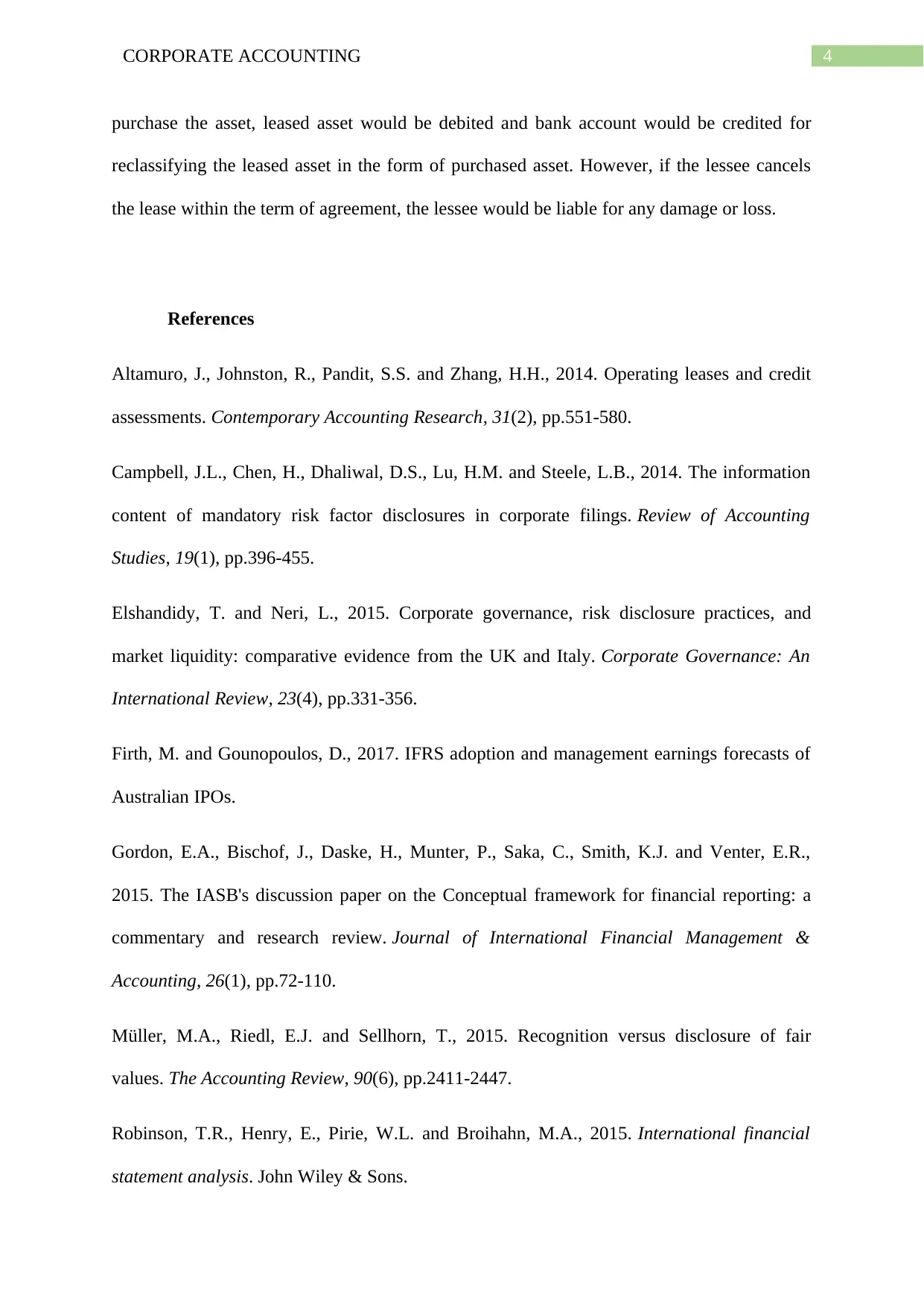
4CORPORATE ACCOUNTING
purchase the asset, leased asset would be debited and bank account would be credited for
reclassifying the leased asset in the form of purchased asset. However, if the lessee cancels
the lease within the term of agreement, the lessee would be liable for any damage or loss.
References
Altamuro, J., Johnston, R., Pandit, S.S. and Zhang, H.H., 2014. Operating leases and credit
assessments. Contemporary Accounting Research, 31(2), pp.551-580.
Campbell, J.L., Chen, H., Dhaliwal, D.S., Lu, H.M. and Steele, L.B., 2014. The information
content of mandatory risk factor disclosures in corporate filings. Review of Accounting
Studies, 19(1), pp.396-455.
Elshandidy, T. and Neri, L., 2015. Corporate governance, risk disclosure practices, and
market liquidity: comparative evidence from the UK and Italy. Corporate Governance: An
International Review, 23(4), pp.331-356.
Firth, M. and Gounopoulos, D., 2017. IFRS adoption and management earnings forecasts of
Australian IPOs.
Gordon, E.A., Bischof, J., Daske, H., Munter, P., Saka, C., Smith, K.J. and Venter, E.R.,
2015. The IASB's discussion paper on the Conceptual framework for financial reporting: a
commentary and research review. Journal of International Financial Management &
Accounting, 26(1), pp.72-110.
Müller, M.A., Riedl, E.J. and Sellhorn, T., 2015. Recognition versus disclosure of fair
values. The Accounting Review, 90(6), pp.2411-2447.
Robinson, T.R., Henry, E., Pirie, W.L. and Broihahn, M.A., 2015. International financial
statement analysis. John Wiley & Sons.
purchase the asset, leased asset would be debited and bank account would be credited for
reclassifying the leased asset in the form of purchased asset. However, if the lessee cancels
the lease within the term of agreement, the lessee would be liable for any damage or loss.
References
Altamuro, J., Johnston, R., Pandit, S.S. and Zhang, H.H., 2014. Operating leases and credit
assessments. Contemporary Accounting Research, 31(2), pp.551-580.
Campbell, J.L., Chen, H., Dhaliwal, D.S., Lu, H.M. and Steele, L.B., 2014. The information
content of mandatory risk factor disclosures in corporate filings. Review of Accounting
Studies, 19(1), pp.396-455.
Elshandidy, T. and Neri, L., 2015. Corporate governance, risk disclosure practices, and
market liquidity: comparative evidence from the UK and Italy. Corporate Governance: An
International Review, 23(4), pp.331-356.
Firth, M. and Gounopoulos, D., 2017. IFRS adoption and management earnings forecasts of
Australian IPOs.
Gordon, E.A., Bischof, J., Daske, H., Munter, P., Saka, C., Smith, K.J. and Venter, E.R.,
2015. The IASB's discussion paper on the Conceptual framework for financial reporting: a
commentary and research review. Journal of International Financial Management &
Accounting, 26(1), pp.72-110.
Müller, M.A., Riedl, E.J. and Sellhorn, T., 2015. Recognition versus disclosure of fair
values. The Accounting Review, 90(6), pp.2411-2447.
Robinson, T.R., Henry, E., Pirie, W.L. and Broihahn, M.A., 2015. International financial
statement analysis. John Wiley & Sons.
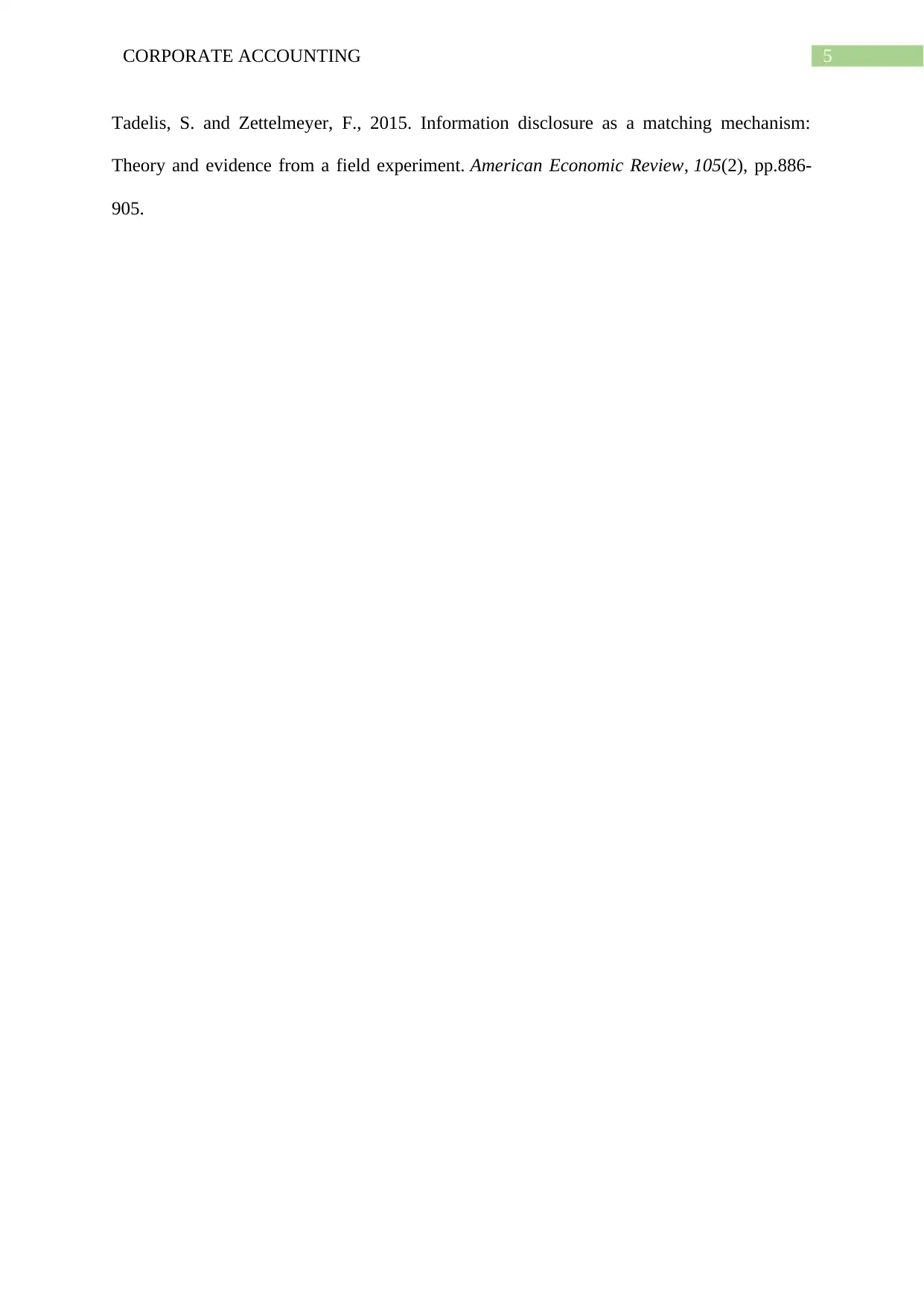
5CORPORATE ACCOUNTING
Tadelis, S. and Zettelmeyer, F., 2015. Information disclosure as a matching mechanism:
Theory and evidence from a field experiment. American Economic Review, 105(2), pp.886-
905.
Tadelis, S. and Zettelmeyer, F., 2015. Information disclosure as a matching mechanism:
Theory and evidence from a field experiment. American Economic Review, 105(2), pp.886-
905.
1 out of 6
Related Documents
Your All-in-One AI-Powered Toolkit for Academic Success.
+13062052269
info@desklib.com
Available 24*7 on WhatsApp / Email
![[object Object]](/_next/static/media/star-bottom.7253800d.svg)
Unlock your academic potential
© 2024 | Zucol Services PVT LTD | All rights reserved.




